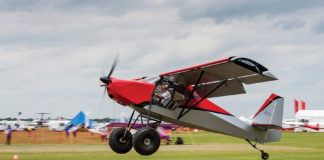During a flight, the pilot must perform a variety of longitudinal control tasks including rotating for takeoff, capturing a pitch attitude, changing airspeed, capturing and holding the target airspeed, and holding a desired load factor (G level) in a maneuver or flaring for landing. It is the designers job to make the airplane comfortably controllable in pitch so that the pilot can perform these tasks easily. Obviously, the stick forces must be low enough, and the control power high enough, that the pilot is physically able to control the airplane. Accordingly, designers in general try to keep control forces down. It is possible, however, to go overboard and make the control forces too light, which causes problems that are completely different from those caused by too-heavy control forces but can be just as serious.
Pilots perceive airplanes as pitch sensitive when small changes in stick force and/or stick position cause large pitch perturbations. To the pilot, the airplane feels like it wants to overshoot the commanded attitude or load factor in response to a pitch control input. This characteristic can dramatically increase pilot workload, as the pilot will end up making a large number of control inputs to maintain the desired state of flight. The majority of these control motions will be made to counteract the overshoot caused by the previous input. The pilot is, in effect, continuously chasing the airplane in pitch.
This is annoying enough in level flight in calm air. The problem becomes more serious when the airplane is perturbed by turbulence or a change in configuration such as the extension or retraction of the landing gear or flaps. In some cases, the overshooting and correcting caused by the oversensitive pitch control can lead to pilot-induced oscillation (PIO). Actually, the term is a bit misleading, because the pilot is not primarily at fault. The problem is caused by the interaction between the pilot and the control response of the airplane. Pilot-induced oscillation is one of the more dangerous types of flying qualities defect because it can lead to loss of control of the airplane. The spectacular mishap that befell the YF-22 fighter prototype was the result of a PIO triggered by excessive pitch sensitivity combined with a sudden trim change due to a change in the configuration of the airplane. The more recent crash of a Saab Gripen at an airshow was also at least in part PIO induced.
Another factor affected by oversensitive controls in any axis is pilot attention. Normally, a pilot divides attention between the several control tasks at hand. If controlling the airplane in one axis demands an undue amount of continuous attention, there will be a tendency to neglect other control tasks. Because of this phenomenon, excessive pitch sensitivity can cause poor performance on lateral/directional tasks such as tracking the runway centerline on landing, and capturing target bank angles and headings when rolling into and out of turns. The pilot is concentrating on pitch control, and hence cannot pay enough attention to roll and yaw to fly precisely. For an airplane that is to be flown in turbulence or IFR, this is unacceptable.
When a pitch-sensitivity problem appears, most builders try to fix it by moving the cg forward or enlarging the horizontal tail. Both of these tactics aim to increase the pitch stability of the airplane. Sometimes this works to tame the longitudinal flying qualities, but sometimes it is not as successful as hoped. Even when these approaches work, they may exact a performance penalty that would not have been necessary if the problem had been addressed differently.
There are many factors that can contribute to an overall impression of pitch sensitivity in an airplane. Before attempting to fix a pitch-feel issue, the designer must clearly identify which particular effect is causing the problem. Otherwise, he may blindly move ahead trying to cure the wrong disease.
One set of parameters that must be considered describes the feedback a pilot gets from the control stick. These must be adjusted to give the pilot a comfortable control feel.
Stick Force Per G
The most important parameter quantifying pitch-control characteristics is called stick force per G. This is defined as the amount of force the pilot must exert on the stick to change the trimmed load factor by 1 G. For example, consider an airplane that is trimmed in 1 G level flight. If the pilot must pull 10 pounds on the stick to pull 2 G, starting from the initial trimmed condition, then the airplane has a stick force per G of 10 pounds. The higher the stick force per G, the heavier the pitch feel of the airplane, and the less sensitive it will feel to the pilot. Conversely, decreasing stick force per G causes the pilot to consider the airplane more pitch sensitive.
MIL F-8785C is the basic Military Specification (MIL SPEC) for airplane flying qualities. It calls out the following as the minimum acceptable stick force per G in maneuvering flight for airplanes with sticks:
Minimum stick force per G = 12/(Nl-1) or 3 pounds per G, whichever is greater.
Nl is the limit load factor of the plane.
For example, for an airplane with a 6 G limit load, this criterion gives 4.2 pounds of stick force per G as the minimum acceptable level. If the stick force per G is less than 3 pounds, it is unacceptable regardless of the limit load factor of the airplane.
Stick Force to Stick Deflection Ratio
The amount of force required to move the stick also affects the pilots perception of pitch sensitivity. If the stick requires too little force to move, the airplane will feel sensitive. Referring again to MIL F-8785C, we find that the force required to move the stick should not be less than 5 pounds per inch. For an airplane with a pilot-powered mechanical control system, this parameter is closely linked to stick force per G. The mechanical gearing between the pilot and the elevators affects them both.
Stick Force Velocity Gradient
The stick force velocity gradient is the amount of stick force required to change the trimmed airspeed 1 knot and hold the airplane at the new airspeed. If this is too low, then small stick forces will cause relatively large airspeed changes, which make it difficult for a pilot to capture and hold a desired airspeed. It is even possible for the stick force velocity gradient to be reversed (unstable) for an otherwise stable airplane. This situation is uncomfortable to say the least, because the pilot must pull on the stick to hold the airplane at a higher-than-trimmed airspeed and must push to keep it at a lower-than-trimmed airspeed.
Stick Travel
At one time it was believed that a pilots pitch-control cues came entirely from stick force rather than stick movement. The earliest F-16 prototypes had sticks that did not move at all. Stick force inputs from the pilot were sensed electronically, and the information was fed into the flight-control computer to command the control surfaces. When this system began flying, pilots did not like it, preferring some movement in the stick to give additional cues to
control inputs. The angular movement of the stick turned out to be an important pitch-control cue for the pilots. If small motions of the stick produce large control inputs, the pilot will get an
overall impression that the controls are sensitive even if the force gradients are high enough to be acceptable.
Aerodynamic & Mechanical Factors
Looking downstream of the pilot/stick interface, we come to the aerodynamic and mechanical aspects of the control system and the overall airplane that determine its flying qualities. These are the things that the designer can work with to affect the pilot-feedback items we have just discussed.
Static Margin
The static margin (SM) is a measure of the overall pitch stability of the airplane. It is defined as the distance between the cg and the aerodynamic center (AC) or neutral point of the airplane. Static margin is measured in units of percent of the mean aerodynamic chord (MAC), and it is positive if the cg is forward of the AC. The larger the positive static margin, the more stable the airplane. If the static margin reaches zero, the airplane will be neutrally stable, and negative SM means an unstable airplane. An airplane with insufficient static margin will require very little elevator deflection to cause a large change in angle of attack and will thus be difficult to control.
An excessively aft cg is one common cause of unacceptably sensitive pitch control. Depending on other factors, some airplanes can be flyable with neutral or even slightly negative static margins, but they are difficult to fly in this condition, and it is never desirable to do so without a computerized flight-control system.
When designers attempt to fix longitudinal flying qualities problems by moving the cg forward, moving the wing aft or enlarging the horizontal tail, what they are really trying to do is increase the static margin of the airplane.
Control Surface Restoring Tendency
When a stable control surface is deflected, the aerodynamic force on the surface creates a moment about the hinge line that tends to drive the surface back towards its undeflected position. The restoring tendency is the amount of hinge moment per degree of deflection a control surface generates. The larger the restoring tendency, the more moment, and hence stick force, it will take to deflect it from its neutral position. Accordingly, restoring tendency is one of the strongest determiners of stick force characteristics.
Restoring tendency is a function of both the size and the shape of the control surface. It is proportional to both the area of the surface and its chord. A large-chord (low-aspect-ratio) surface will be harder to deflect than a small-chord surface of the same total area. Other factors that have a large effect on restoring tendency are aerodynamic
balancing and the shape of the trailing edge of the surface.
Control Surface Floating Tendency
The floating tendency is the hinge moment generated on a control surface
in response to a change in the angle of attack of the whole airplane. The moment generated makes the surface
tend to align itself with the apparent wind, or “float” with the airstream. Floating elevators reduce the static margin of a conventional aft-tail airplane, because a surface that is floating with the wind does not change its lift when the angle of attack of the airplane changes. It therefore produces no stabilizing forces. Interestingly, this effect is reversed for canard airplanes with elevators on the foreplane, because the foreplane is actually destabilizing.
Reducing the change of lift with angle of attack by floating the elevators
actually increases static margin.
The floating tendency is responsible for the difference between stick-fixed stability and stick-free stability on airplanes with mechanical control systems. Because the floating tendency of the elevators is destabilizing on conventional airplanes, it can contribute to pitch-control problems. It is, in particular, a major player in the speed stability of the airplane.
Control Gearing
The force the pilot must exert on the stick to move the elevators is a function of both the aerodynamically generated hinge moments on the control surface and the mechanical advantage the pilot is given by the control system linking the stick to the elevators. The greater the stick movement per degree of control-surface deflection, the lower
the stick force required to move the surface. Making the stick longer will lighten the control forces but increase the throw required to move them. Shortening the stick makes the forces higher but reduces the throw. Adjusting the relative lengths of the arms in the control system can have similar effects. These control arms include the horns on the surfaces themselves, the attachment points of the control cable or pushrods to the stick, and the idlers and bellcranks (if any) that are between the stick and the control surface.
Elevator Control Power
The control power of the elevators plays an important part in the longitudinal flying qualities. An elevator that is very easy to move but has little control power may not give an oversensitive pitch feel, but a powerful elevator that requires the same amount of stick force per degree of elevator movement will.
Proper sizing of the elevators is a compromise. They must be powerful enough to trim the airplane at its most forward cg position with the gear and flaps down. They must be easy enough to move so that the control forces in this situation are manageable. When the cg is moved aft to the aft limit, much less control power is required, but it is necessary to keep the stick force per G above the minimum acceptable value.













